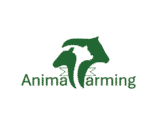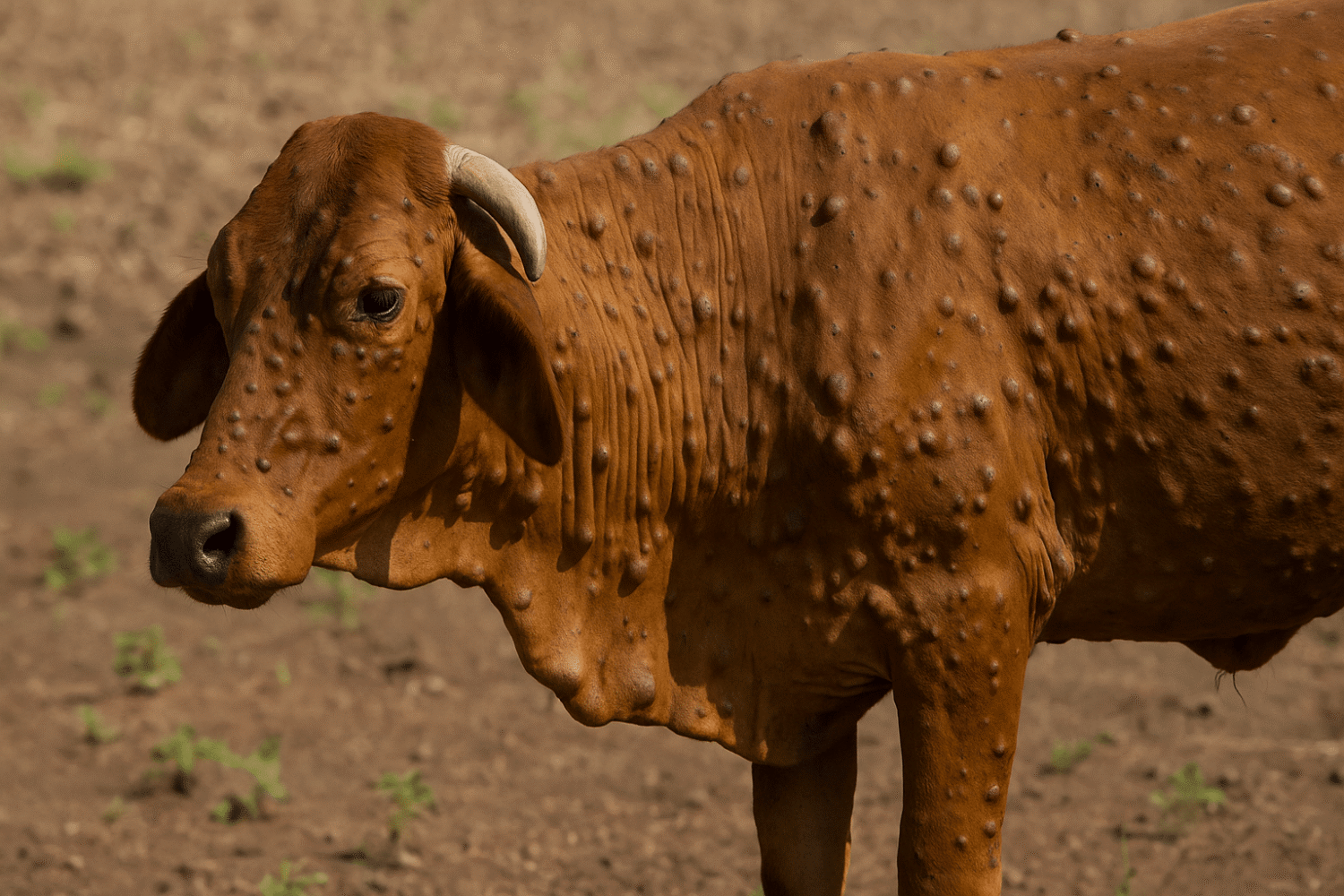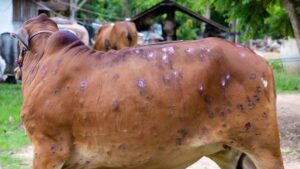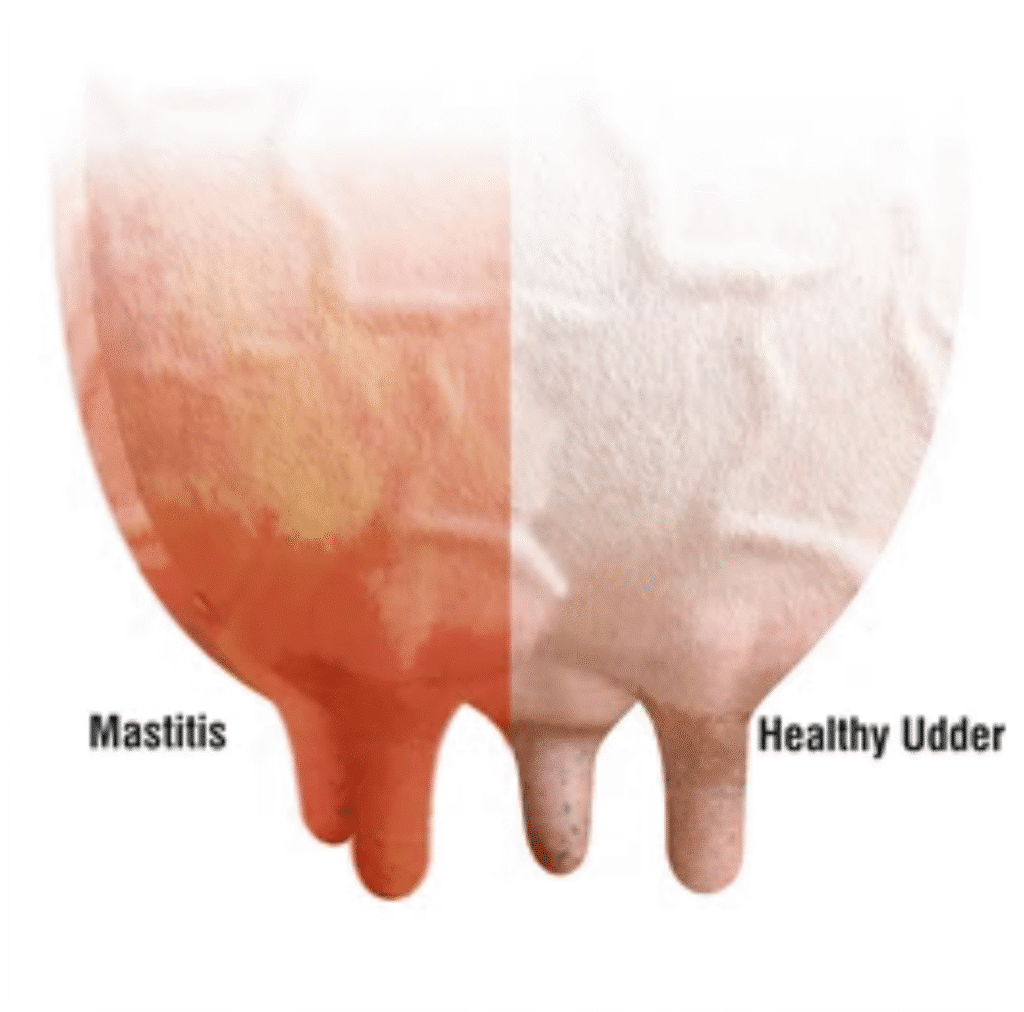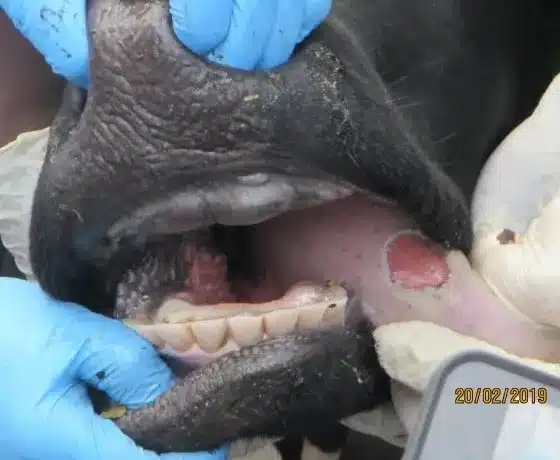Lumpy skin disease in cattle’s is an infectious viral disease of cattle caused by the lumpy skin disease virus (LSDV), a member of the Capripoxvirus genus. The development of firm nodules primarily characterizes the disease, often accompanied by fever, swelling of superficial lymph nodes, and reduced feed intake. Sometimes, animals with lumpy skin disease can develop other problems like pneumonia, infections, mastitis, or even infertility. LSD causes decreased milk production, damaged skin, weight loss, and sometimes trade restrictions for affected animals, which leads to significant losses for farmers. That’s why it’s a serious concern for farmers and animal health experts.
Initially reported in southern Africa in the early 20th century, the disease remained confined to that region for several decades. However, from the 1970s onwards, LSD began expanding its reach—first across sub-Saharan Africa, then into the Middle East and parts of Eastern Europe. Lumpy skin disease is increasing its geographical footprint, with recent outbreaks reported in South and East Asia, including countries such as India, Bangladesh, China, and Russia.
The continued spread of LSD into previously unaffected regions has raised significant international concern. Authorities have not yet detected the disease in the Americas, Australia, or New Zealand. Its rapid movement across continents emphasizes the need for awareness, early detection, and effective control strategies.
The following sections will cover the most critical aspects of lumpy skin disease (LSD). These include how the lumpy skin disease virus spreads and how the (LSD) disease progresses in infected cattle. You’ll also learn about diagnosis, treatment options, and ways to prevent the disease to reduce its impact on cattle worldwide.
Symptoms of Lumpy Skin Disease in Cattle
Lumpy skin disease (LSD) usually begins with a sudden high fever above 40.5°C (104.9°F), along with lethargy, reduced appetite, and general discomfort. Within a few days, cattle develop firm, round skin nodules (2–5 cm) on the head, neck, back, limbs, udder, and genitalia. In severe cases, these nodules may spread throughout the body, become necrotic, form scabs, or develop into open wounds prone to secondary infections. Common secondary complications include abscesses, myiasis, mastitis, pneumonia, and lameness.
Additional signs of Lumpy skin Disease include nasal and eye discharge, excessive salivation, and swollen lymph nodes, especially around the head and neck. Edema of the brisket, legs, and udder is also common, making movement painful. Milk production drops sharply, while bulls may develop swollen testicles and pregnant cows may abort.
Although mortality is usually low, LSD leads to significant economic losses due to weight loss, damaged hides, reduced fertility, and prolonged recovery. Prompt recognition of symptoms and veterinary intervention is essential to limit disease spread and minimize herd impact.
Causes of Lumpy Skin Disease in Cattle
A virus known as the Lumpy Skin Disease Virus (LSDV) causes lumpy skin disease in cattle. This virus belongs to the same family as those that cause sheeppox and goatpox, but it primarily affects cattle. After entering the animal’s body, the virus causes swelling in the skin and lymph nodes, leading to the formation of firm, painful lumps on the skin. It can also affect the lungs, digestive system, and reproductive organs. The virus is strong and can survive for a long time in dried scabs or on contaminated equipment, making it difficult to eradicate from farms once it’s present.
This Lumpy Skin Disease virus’s ability to evade the animal’s immune system is more dangerous. It has special features that confuse the immune response, allowing it to stay inside the body longer and cause more damage. Cattle that are weak, stressed, or not properly fed may become sicker if they contract the virus, as their bodies are less able to fight it off effectively. The virus is the primary cause of lumpy skin disease in cattle, and once it infects an animal, it can result in weight loss, reduced milk production, and long-lasting skin damage.
Lumpy Skin Disease Virus (LSDV): The Causative Agent
The lumpy skin disease virus (LSDV) causes lumpy skin disease, which is a large, double-stranded DNA virus belonging to the Capripoxvirus genus within the Poxviridae family. The virus replicates in the cytoplasm of infected cells, forming distinct viral inclusion bodies. It is genetically stable and highly resilient, surviving in dried scabs and contaminated surfaces for extended periods. The LSD virus mainly attacks specific immune and blood vessel cells (macrophages and vascular endothelial cells) in the animal’s body, causing swelling and damage to tissues. It has a special outer layer that helps it hide from the immune system, allowing it to stay in the body longer. Although it does not replicate in insect vectors, its robust structure will enable it to remain infectious during mechanical transfer between animals.
Diagnosis of Lumpy Skin Disease in Cattle
Accurate and timely diagnosis of lumpy skin disease (LSD) is vital for effective disease control and minimizing its spread within and between herds. Veterinarians generally diagnose lumpy skin disease by combining a clinical examination of visible signs with laboratory tests to confirm the presence of
the lumpy skin disease virus (LSDV). Each step plays a crucial role in accurately identifying and differentiating the disease from similar skin conditions in cattle.
1. Clinical Observation and Common Signs
The first indication of LSD infection often comes from the visible and behavioral symptoms
observed by farmers or veterinarians during physical examination. Cattle with LSD typically exhibit a sudden onset of high fever, usually exceeding 40°C (104°F), along with general signs of discomfort such as depression, reduced feed intake, and reluctance to move.
One of the most distinguishing features is the presence of firm, round skin nodules ranging from 2 to 5 cm in diameter. These nodules initially appear on the head, neck, limbs, back, and udder and may later spread across the entire body. Over time, these nodules can become necrotic ulcerate and form thick, crusted scabs. In severe cases, the skin lesions may lead to deep tissue damage and secondary infections.
Additional signs often include swelling of superficial lymph nodes, particularly around the head and neck, as well as nasal and ocular discharge. Affected animals may also produce excessive saliva, and edema of the brisket, limbs, and udder is common. These symptoms often cause pain and mobility issues, making the cattle reluctant to walk or rise. In bulls, the scrotum may become swollen and inflamed, while in cows, udder lesions may reduce milk production or lead to mastitis. Pregnant cows are at risk of abortion due to systemic illness.
Clinical diagnosis is especially important in regions where LSD is already present, as a rapid visual assessment can guide immediate isolation and control efforts. However, because other conditions—such as pseudo-lumpy skin disease, bovine herpesvirus infections, or insect bite reactions—can mimic LSD, laboratory confirmation is essential.
2. Laboratory Confirmation of Lumpy Skin Virus
Although clinical signs can point toward LSD, confirming the diagnosis requires laboratory testing—particularly in the early stages or in areas where the disease is just starting to appear. Lab tests are also essential for distinguishing LSD from other diseases with similar symptoms and for accurate reporting and monitoring.
Sample Collection
The most reliable diagnostic samples include:
- Skin nodules or scab material from affected areas.
- Veterinarians occasionally take blood samples during the early stages of infection.
Store collected samples in phosphate-buffered saline (PBS) or a glycerol-based transport medium with a pH of 7.2–7.6. It is critical to keep the samples cool using ice packs or refrigeration until they reach the laboratory to preserve viral integrity.
Diagnostic Tests
A combination of diagnostic techniques may be used depending on the laboratory’s capabilities and the stage of disease:
PCR (Polymerase Chain Reaction):
This is the most sensitive and specific method for detecting LSDV DNA in skin or blood samples. Veterinarians widely use PCR during outbreaks because it provides rapid confirmation of the virus.
Virus Isolation:
Specialists grow the virus in cell cultures to confirm the virus—a method that, while highly accurate, takes more time and is usually performed in reference laboratories.
ELISA (Enzyme-Linked Immunosorbent Assay):
This test detects antibodies against LSDV in the animal’s blood, indicating prior exposure or vaccine response. It is not useful for confirming active infection but helps in serological surveillance.
Histopathology:
When a small skin sample is examined under a microscope, it often shows clear signs of
damage caused by the virus. These changes give vets important clues and help confirm that the animal is suffering from lumpy skin disease.
Lateral Flow (Rapid Antigen) Tests:
These are useful for field-level, rapid screening but may lack the sensitivity of PCR tests.
It’s important to note that only PCR and virus isolation can confirm an active LSD infection, while serological tests help assess the spread and immunity status of the herd.
Treatment of Lumpy Skin Disease in Cattle
There is no direct treatment for lumpy skin disease in cattle because it is a viral infection. However, supportive treatments—such as managing symptoms, preventing secondary infections, and supporting immune recovery—can help cattle recover. 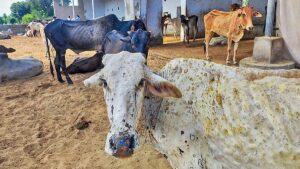
Prompt isolation, supportive care, wound management, and vaccination are the pillars of effective LSD control. Taking quick action not only helps the sick animals recover faster but also reduces the risk of the disease spreading to other animals in the same herd or nearby herds.
However, there are few supportive treatments for lumpy skin disease, such as wound care, proper cleaning, and the use of antibiotics, which help the animal recover faster.
Supportive Treatment for Lumpy Skin Disease
Giving animals proper supportive care makes a big difference—it helps them heal better and lessens the overall impact of lumpy skin disease on their health and well-being. It includes managing fever, pain, and secondary skin infections, especially in cattle suffering from large necrotic skin nodules or lumpy swellings on the limbs and body.
Wound Cleaning and Management
One of the most challenging aspects of lumpy skin disease is the development of deep skin nodules that may ulcerate and become infected. Proper cleaning and topical treatment are crucial in preventing fly infestations and abscess formation.
Steps for Wound Care in Lumpy Skin Disease
Taking care of wounds the right way is very important. It helps prevent other infections, supports faster healing, and lowers the chance of maggots developing in cattle suffering from lumpy skin disease. Follow these veterinary-recommended steps:
Cleaning the Affected Areas
Gently clean the wounds using diluted antiseptic solutions such as:
- Povidone-iodine (1–2% solution)
- Potassium permanganate (light pink solution)
Frequency: Clean the wounds twice daily (morning and evening) until visible healing begins.
Duration: Continue for at least 5–7 days, or longer if infection persists.
Scab Management
If scabs become infected, infested with flies, or remain moist, You should gently soften the scabs with warm saline and then carefully remove them before cleaning the affected area.
Do not forcibly remove dry or healing scabs, as this may delay recovery.
Topical Treatment
After cleaning, apply one of the following to the affected areas:
- Zinc oxide ointments (to promote skin regeneration)
- Antiseptic sprays (e.g., chlorhexidine-based)
- Fly repellents (to prevent myiasis or maggot development)
Reapply after each cleaning session (i.e., twice a day).
In high fly-burden environments, fly repellents can be applied three times daily around wounds for better protection.
Antibiotics in Lumpy Skin Disease
Though LSD is viral, secondary bacterial infections commonly complicate recovery. In such cases, veterinarians prescribe antibiotics to help prevent or treat skin infections associated with lumpy skin disease, joint swelling (septic arthritis), or pneumonia.
Recommended Antibiotics for Secondary Infection:
| Antibiotic Name | Route | Brand Examples |
| Oxytetracycline | IM/IV | Terramycin, Alamycin |
| Penicillin-Streptomycin | IM | Pen & Strep |
| Enrofloxacin | IM/SC | Baytril, Enrocin |
Treatment duration may vary from 3 to 7 days, depending on the severity of lesions or systemic infection.
Immune and Nutritional Support
Helping the animal’s immune system stay strong is key to faster recovery and fewer problems from lumpy skin disease. Cattle that are weak, stressed, or not eating well often take longer to heal and are more likely to develop other infections.
Recommended Supplements:
- Multivitamins: A, D, E
- Trace minerals: Zinc, Selenium
- Oral electrolyte solutions
- Yeast-based immune boosters or prebiotics
These supplements support wound healing, maintain hydration, and improve disease resistance.
Vaccination Against Lumpy Skin Disease
Vaccination does not treat existing cases, but it is key in limiting the spread of disease. In outbreak zones, Veterinarians should promptly vaccinate healthy animals using regionally approved live attenuated vaccines.
Common LSD Vaccines:
- LSDV Neethling strain (live attenuated)
- Capripox-based homologous vaccines
- Emergency ring vaccination within a 10 km radius of affected farms
Veterinarians should monitor vaccinated animals for mild reactions, which typically resolve on their own without treatment.
When to Use Antibiotics or NSAIDs in LSD Cases
Condition Recommended Action:
| High fever, swelling, poor appetite | NSAIDs (e.g., Flunixin, Meloxicam) |
| Skin nodules with pus or maggots | Antibiotics + wound care |
| Jaw or facial swelling: Assess for lumpy jaw in cattle | start penicillin-based therapy |
| Weakness, dehydration | Nutritional and immune support, electrolytes |
This comprehensive lumpy skin disease in cattle treatment protocol emphasizes early action, consistent care, and prevention through biosecurity and vaccination. Always consult a licensed veterinarian for case-specific advice and drug dosing.
Transmission of Lumpy Skin Disease in Cattle
Lumpy skin disease mainly spreads through biting insects like flies and mosquitoes rather than direct contact between animals. The virus often relies on these insects or contaminated tools and environments to reach healthy cattle, which makes controlling its spread in herds more difficult. The main transmission factors include biting insects (e.g., mosquitoes, ticks, and flies), contaminated equipment, direct contact with infected animals, shared water sources, and exposure to virus-laden scabs or secretions.
Insect Vector Transmission
The most dominant route of lumpy skin disease transmission is biting insects, especially stable flies (Stomoxys calcitrans), mosquitoes, and midges. These vectors mechanically transfer the lumpy skin virus from the skin lesions or blood of infected animals to uninfected ones while feeding. Regions with high insect populations often see rapid outbreaks of bovine lumpy skin disease, especially in warm, humid climates where these insects thrive.
Contaminated Materials and Indirect Spread
The virus can also persist in the environment and spread through contaminated tools, feeding troughs, water sources, and the clothing or hands of handlers. Infected cattle shed the virus in their saliva, nasal discharge, milk, semen, and skin nodules. When healthy animals come into contact with these contaminated materials—especially through open wounds or mucosal surfaces—the risk of transmission increases significantly.
Movement of Animals and Shared Equipment
The unnoticed movement of infected animals, especially those in the incubation or recovery phase, contributes to the silent spread of the disease. Using uncleaned equipment between herds, such as syringes, halters, or grooming tools, also facilitates the transmission of skin diseases in cattle, including bovine lumpy skin disease, from one group to another.
Prevention of Lumpy Skin Disease in Cattle
Preventing lumpy skin disease in cattle requires a combination of vaccination, insect control, and strict biosecurity. Since the lumpy skin virus spreads mainly through insect bites and contaminated materials, proactive measures are essential, especially in endemic or high-risk regions.
Vaccination
Vaccination is the most effective tool against lumpy skin disease. Live attenuated vaccines—often derived from sheeppox or goatpox strains—offer cross-protection and are widely used in outbreak control and routine prevention. Vaccines should be administered annually or as advised by veterinary authorities, with booster shots provided during high-risk seasons. Only healthy animals should be vaccinated, and proper cold chain storage is critical for vaccine efficacy.
Insect Vector Control
Vector control is vital to reduce disease spread. Using insecticides (sprays, pour-ons), installing nets, and eliminating breeding sites like stagnant water help control flies, mosquitoes, and ticks that carry the lumpy skin virus between animals.
Biosecurity and Farm Hygiene
To prevent lumpy skin disease cow cases, isolate new or sick animals, disinfect shared equipment, and limit farm access. Quarantine for 2–4. Quarantining animals for a few weeks after purchase or movement is recommended to prevent introducing the virus into the herd.
Herd Management
Well-fed, low-stress cattle are more resistant to infection. Regular observation for early signs and immediate reporting of suspected cases allow swift containment before the disease spreads widely.
Conclusion
Lumpy skin disease is a serious threat to cattle health and farm productivity, causing economic losses through reduced milk yield, weight loss, infertility, and high treatment costs. Lumpy skin disease mostly spreads through blood-feeding insects like mosquitoes, flies, and ticks. It can also spread through contaminated tools, close contact between animals, or poor hygiene. Catching the disease early, confirming it with proper tests, and giving timely care can help stop it from spreading. To prevent outbreaks, regular vaccination, using insect repellents, and keeping the farm clean are all very important. Controlling animal movement, disinfecting equipment, and educating farmers also play a big role in keeping herds safe. With quick action and good farm management, the impact of the disease can be greatly reduced.
FAQs of lumpy skin disease in cattle’s
What is lumpy skin disease?
Lumpy skin disease (LSD) is a viral infection of cattle and water buffalo caused by the Capripoxvirus, characterized by fever, enlarged lymph nodes, and firm, round nodules on the skin and mucous membranes that may ulcerate and leave scars. It can lead to reduced milk production, emaciation, infertility, hide damage, and occasionally death, and is primarily spread through biting insects and contaminated materials.
What are the symptoms of lumpy skin disease in cattle?
Lumpy skin disease causes firm, round skin nodules, fever, swollen lymph nodes, and reduced appetite. In severe cases, there may be lameness, nasal discharge, and a sharp drop in milk production.
What medicine is used to treat lumpy skin disease in cattle?
There’s no antiviral cure, so treatment focuses on supportive care: broad-spectrum antibiotics (like oxytetracycline, penicillins, or fluoroquinolones) for 5–7 days to prevent secondary infections, along with NSAIDs (e.g., meloxicam, flunixin) and antihistamines to reduce fever, pain, and swelling. Supportive measures—fluids, wound care, and vitamins—help recovery.
Lumpy skin disease in humans?
No, lumpy skin disease is not zoonotic—it strictly infects cattle and water buffalo, with no evidence of causing illness in humans, and dairy or meat from infected animals remains safe for consumption.
Lumpy skin disease caused by?
Lumpy skin disease is caused by the Lumpy Skin Disease Virus (LSDV), a double‑stranded DNA virus in the Capripoxvirus genus of the Poxviridae family. It primarily spreads through mechanical transmission via blood‑feeding insects (mosquitoes, flies, ticks) and can also be transmitted via contaminated secretions, semen, milk, and direct contact.
Lumpy skin disease in cattle?
Lumpy skin disease (LSD) is an acute viral illness caused by the Capripoxvirus, primarily affecting cattle and water buffalo. It presents with fever, enlarged lymph nodes, and characteristic firm, round nodules (2–5 cm) on the skin and mucous membranes, often accompanied by eye/nasal discharge, oedema, lameness, and a sharp drop in milk production. The disease can lead to hide damage, infertility, abortion, and secondary infections like pneumonia, causing notable economic losses.
Is lumpy skin disease contagious?
Yes, LSD is highly contagious among cattle. primarily spread by blood‑feeding insects like mosquitoes, flies, and ticks, and also through direct contact with infected animals or contaminated equipment. It can persist in scabs and secretions for months, enabling indirect transmission via shared tools, bedding, or vehicles.
